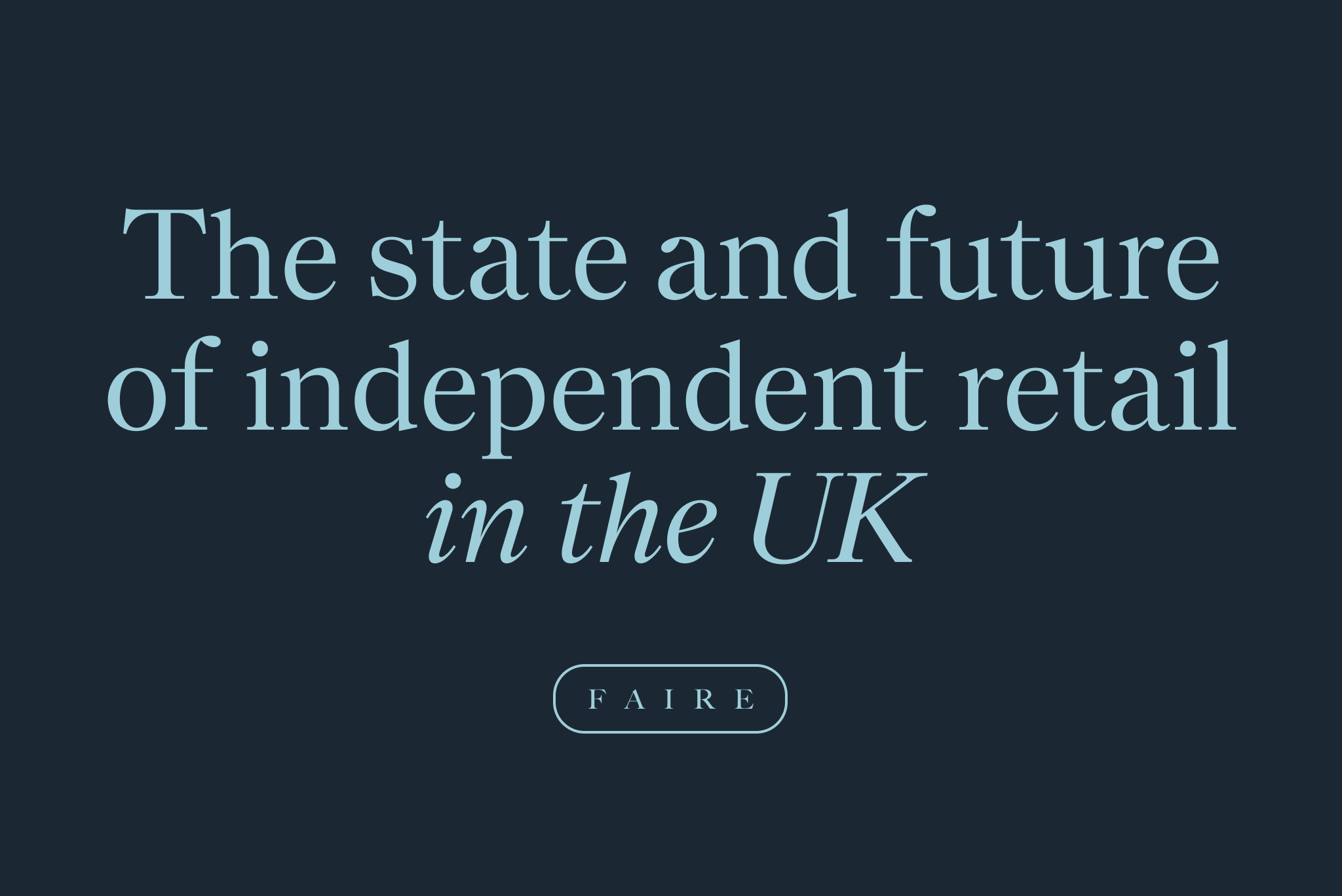

2022 was an unpredictable year. It began in the midst of a pandemic hangover and ended with a looming recession after inflation rates hit a 25-year high. Retailers were forced to ride the waves of 2022 which included shipping nightmares, layoffs, and a change in shopper behaviour as the cost-of-living crisis led to tighter purse strings. But there were positives too: We also saw in-store footfall increasing, returning to almost the same level it was at before the pandemic.
Retailers remain optimistic for 2023. As the uncertainty continues, they’re tasked with finding new and innovative ways to keep their businesses afloat and moving forward. Right now, it’s all to play for, and those that are able to ride whatever waves 2023 brings will have a real chance at progressing.
So what can we expect from independent retail in 2023?
1. The store will become a gallery
75% of retail sales still happen in-store. In fact, the number has increased since the pandemic, with many shoppers favouring the personal experience of speaking to a real-life sales assistant and seeing and touching a product before they buy.
In 2023, retailers will enhance the in-store shopping experience by hosting events, popups, and building a community. In some ways, the store will become a gallery for the retailer and will have a lasting impact on shoppers’ purchasing decisions. Art retailer Hobbycraft launched a series of workshops in 2022 where customers could try out products in expert-led sessions. It cites this as a key factor behind its growth and plans to open more stores in 2023.
In a similar vein, independent book retailer Book-ish in Powys runs five book clubs, over 100 events throughout the year, and a monthly cinema hub.
To solidify this case, Retail Week’s report revealed that 24% of UK retailers plan to hire more staff in 2023 to elevate the human element and provide more engaging in-store experiences.
2. Less frequent, more meaningful communication
Research from Wunderkind revealed that customers want less frequent but more meaningful communication and engagement with retailers in 2023. 43% wanted more personalised messages but less often, while 40% claimed that tailored offers and promotions based on a one-to-one understanding of the shopper were their preferred means of engagement.
Retailers will be more sensitive with their communications in 2023, only contacting shoppers with meaningful offers unique to their specific wants and needs.
3. Sustainability will be at the heart of retail
Deloitte’s recent survey revealed that UK shoppers crave sustainability more than ever. Consumers have increased their focus on buying just what they need and expect retailers to practise sustainability throughout the supply chain. They cite retailers can do this by producing sustainable packaging and products, reducing waste in the manufacturing process, committing to ethical working practices, and reducing their carbon footprint.
One key way we’ll see retailers doing this in 2023 is by shopping locally. We’ll see far more local brands on retailers’ shelves which not only taps into the need for sustainability but also exposes shoppers to a range of new products.
Isle of Wight-based retailer Cavanagh & Baker only stocks products that come from within a 25-mile radius of the island in a valiant attempt to reduce its carbon footprint, while Sheffield’s Small Stuff runs a buy-back scheme and a pre-loved section for shoppers.
4. Continuing success for the UK’s top performers
Our research shows that beauty and wellness, home decor, and paper and novelty have remained the top product categories during the last quarter of 2022 and will continue to perform well in 2023. This correlates with the changing lifestyles of shoppers during tough times: They want to look after themselves, make their homes nice if they’re going out less, and enjoy some much-needed fun and creativity.
5. Emerging new categories
In addition to the top performers, we’ve also taken a look at the rising stars. The numbers show that food and beverage and apparel are going to be hot in 2023, with people planning on bringing food and drink into their homes rather than venturing out to restaurants and bars due to economic restraints.
We’re also seeing a rise in the number of alcohol alternatives, dubbed no- or low-value. The market has grown 180% in the last year and is expected to hit £450 million by 2024. Browse our collection of food and drink products to take advantage of these new categories.
6. Focus on core essentials
Research has found that 51% of shoppers will spend between £50 and £200 less each month on frivolous, non-food shopping next year. Under surging energy bills and the repercussions of high inflation rates, consumers will play it safe and stick to buying essentials. Retailers will curate core essential ranges that will include things like grocery basics and items to keep shoppers warm to meet this need and focus on low-priced, high-value products.
7. Agility and partnerships will be key
The possibilities are endless in 2023, so retailers should stay on their toes and put systems in place that allow them to be agile and pivot in the face of world events.
Strength will come in numbers, and partnering with popular brands and organisations doing great things will put retailers in good stead with their customers. This might mean strengthening local connections with other retailers or partnering with nearby brands to host popups, events, and online collaborations.
Whitley Bay retailer, For The Love Of The North partners with artists from around the North East who often have no other way to sell their products except online. It has created a platform for creative talent while increasing its exposure in the local area.
8. Consistent, reliable product sourcing
Retailers lost almost £2 billion last year due to unpredictable supply chains. They’ve spent 2022 recovering from these issues and have spent a large part of the year seeking out reliable and consistent ways to source products. In 2023, we’ll see an emphasis on retailers finding even more secure sourcing options so they don’t have to overpromise and underdeliver to their customers again.
9. Sustainable delivery options
The supply chain issues affected customer-side shipping too, with “shipaggedon” getting a lot of airtime over the past 12 months. The crisis saw retailers clamouring to find sustainable ways to ship products to their customers in the ways their customers wanted.
In 2023, we’ll start to see a change in the way shoppers want to receive their items. According to Retail Week’s 2023 report, 31% of retailers expect more sustainable delivery options and “click-and-collect in-store same day” to be the most in-demand option. This can be a win-win situation for retailers who can provide shoppers with their most popular shipping option while attracting more customers in-store.
Joco Interiors in Nuneaton offers free shipping on orders over £40 as well as a collect in-store option. With the available choice, shoppers can choose their own experience.
10. First-party data collection for personalisation
The current uncertain climate means many retailers are looking to secure long-term relationships with their customers. But, to do this, they need to create hyper-personalised experiences–something that’s becoming increasingly difficult with tightening privacy laws and the abolishment of cookies (the fact that 64% of UK consumers believe cookie tracking is “creepy” doesn’t help matters).
According to research by Marketing Tech News, 86% of UK shoppers want suggested products based on their preferences in return for their loyalty. So, in 2023, we’ll see retailers looking for ways they can learn more about their customers on their own terms through models like subscription services and loyalty schemes. Technology will also provide a low-cost way for retailers to create personalised experiences on autopilot.
The Naked Pantry in the New Forest runs a subscription scheme that helps shoppers reduce their carbon footprint with a selection of goodies and tips each month.
2023 is here. Upcoming retail trends focus on supporting customers during difficult times, creating unique shopping experiences, and partnering with local brands. Get your 2023 off to a good start by browsing our latest sustainable, locally-sourced wholesale products.




